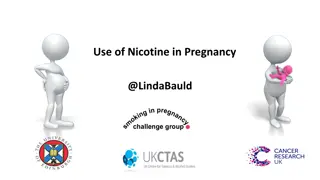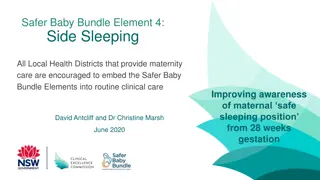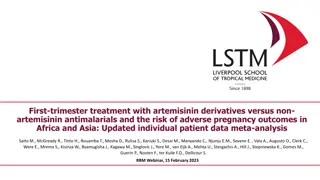Understanding Stillbirth: Causes, Symptoms, and Investigations
Stillbirth, the delivery of a baby with no signs of life after 20 completed weeks of pregnancy, can have profound emotional and social effects. Unexplained causes account for 50% of cases, with fetal, placental, and maternal factors contributing. Risk factors include obesity, maternal age, smoking,
2 views • 26 slides
Impact of Nicotine Use in Pregnancy: Risks and Consequences
Smoking and nicotine use during pregnancy pose significant risks, including low birth weight, stillbirth, miscarriage, preterm birth, heart defects, and Sudden Infant Death Syndrome. Nicotine Replacement Therapy is licensed for pregnant women but lacks evidence of effectiveness in smoking cessation
1 views • 23 slides
Feasibility of Minimally Invasive Tissue Sampling (MITS) in Home Setting in Butajira, Ethiopia at Africa Mortality Symposium
Neonatal mortality and stillbirth rates are significant in Ethiopia, highlighting the need for effective strategies like Minimally Invasive Tissue Sampling (MITS). This study aims to assess the feasibility of implementing MITS in home settings in Butajira through a detailed analysis of objectives, m
0 views • 14 slides
Safer Baby Bundle Element 4: Side Sleeping in Late Pregnancy Position Statement
Research suggests that changing sleeping position in late pregnancy can reduce the risk of stillbirth. Sleeping on the side from 28 weeks gestation can potentially avoid 1 in 10 stillbirths. The inferior vena cava compression in the supine position reduces blood flow to the fetus. Health districts a
0 views • 10 slides
Reflections on Mortality in "Auto Wreck" by Karl Shapiro
The poem "Auto Wreck" vividly describes the aftermath of a car crash, highlighting the chaotic scene and the emotional reactions of witnesses. It delves into the unsettling nature of death, contrasting the randomness of the crash with the more understandable forms of mortality like war, suicide, sti
0 views • 46 slides
Comparison of Artemisinin-Based vs. Non-Artemisinin Treatment in First-Trimester Malaria and Pregnancy Outcomes
Updated meta-analysis compares outcomes of artemisinin-based and non-artemisinin treatment in first-trimester malaria. Artemisinin considered safe in pregnancy, with WHO updates recommending artemether-lumefantrine (AL) in the first trimester. Study aims to assess risk of adverse pregnancy outcomes
0 views • 14 slides





